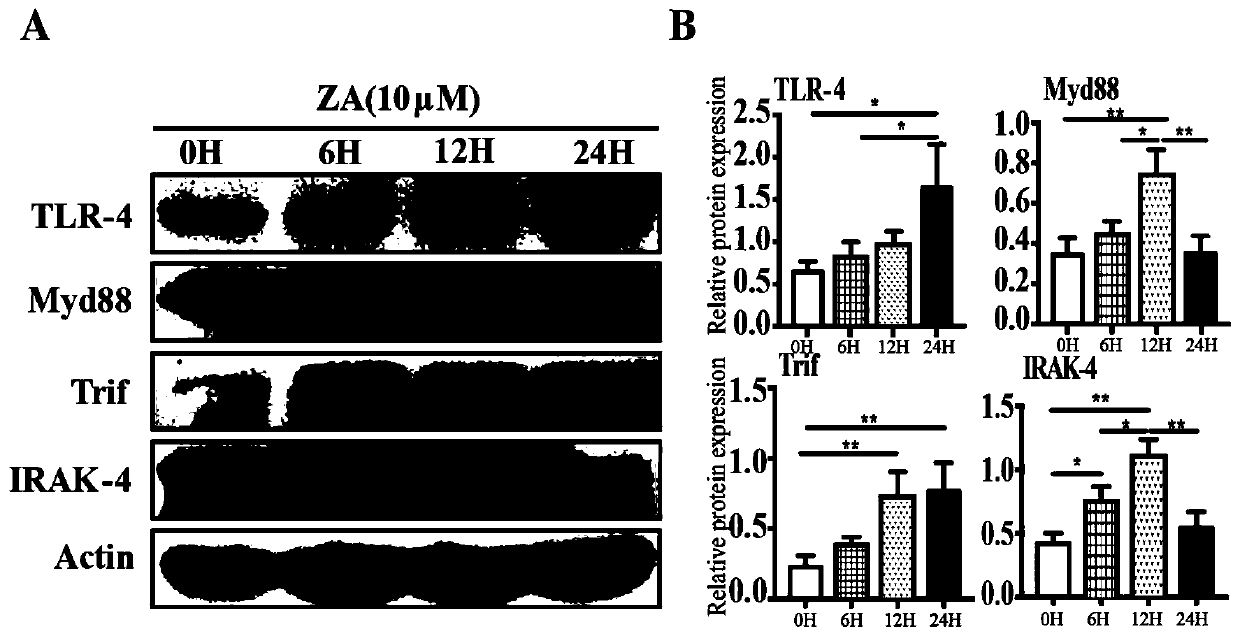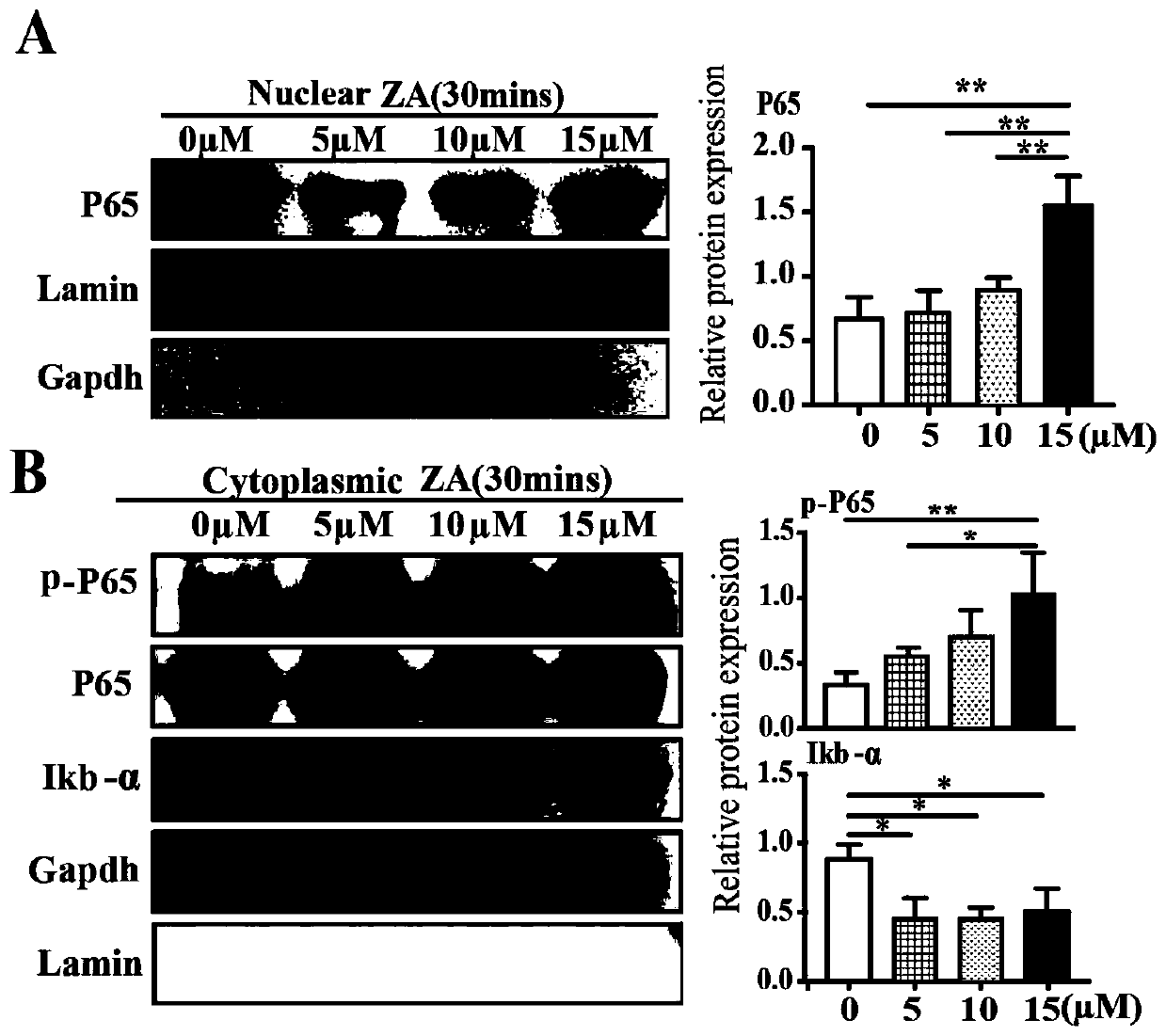Application of TLR4 inhibitor in preparation of medicament for treating tooth extraction wound healing disorder caused by bisphosphonate-related osteonecrosis of the jaw (BRONJ)
A technology of inhibitors and tooth extraction wounds, applied in the field of medicine, can solve problems such as poor bone healing, achieve the effect of promoting the healing of tooth extraction wounds, improving speed and quality, and reducing the formation of sequestrum
- Summary
- Abstract
- Description
- Claims
- Application Information
AI Technical Summary
Problems solved by technology
Method used
Image
Examples
Embodiment 1
[0023] Example 1 Experimental test of zoledronic acid promoting macrophage M1 polarization.
[0024] In order to simulate the effect of ZA on macrophages in the body, the inventors used ZA (zoledronic acid, 10 μM, Zometa, Novartis, USA) to treat primary macrophages derived from mouse bone marrow for 24 hours, then extracted the total protein of the cells, and used The expression of polarity conversion specific markers CD86 and CD206 was detected by western blot.
[0025] Methods as below:
[0026] ①Extraction of total cell protein
[0027] A. Take out the normal culture bottle of cells, pour off the culture medium, add 3ml 4 ℃ pre-cooled PBS solution (0.01mol / L, pH 7.4) to each bottle of cells, lay flat and gently shake for 1min to wash the cells, then discard the washing solution. Repeat the above operation three times, and turn the culture bottle upside down on absorbent paper to blot dry.
[0028] B. Add 10ul PMSF (100mM) to 1ml of the lysate, shake well and place on ice...
Embodiment 2
[0051] Example 2 Experimental test on the activation of TLR4 signaling pathway in macrophages after ZA treatment.
[0052] The inventors detected the activation of the TLR-4 signaling pathway and its downstream key targets in macrophages treated with ZA (10 μM, Zometa) for 24 hours, the method was the same as in Example 1.
[0053] figure 2 It is the western blot detection result of the activation of TLR-4 signaling pathway and its downstream key targets in macrophages after ZA treatment, figure 2 middle, figure 2 A is a western blot diagram, figure 2 B for figure 2 The quantitative statistical results of A, * means p<0.05, ** means p<0.01. It can be seen that macrophages treated with ZA promote the expression of TLR-4, MYD88, TRIF, and IRAK-4 at the protein level. It shows that the treatment of ZA can activate TLR-4 signaling pathway.
Embodiment 3
[0054] Example 3 Experimental test of zoledronic acid promoting macrophage NF-κB nuclear translocation.
[0055] Macrophages were treated with different concentrations of ZA (5 μM, 10 μM, 15 μM) for 30 min, and then nuclear proteins were extracted. Western blot was used to detect the nuclear translocation of NF-κB in macrophages after being stimulated by zoledronic acid.
[0056] The method of extracting nuclear protein is as follows:
[0057] a. Take the treated cells, centrifuge at 4°C, 500xg, and collect the cells for 3 minutes, discard the culture medium, and wash twice with pre-cooled PBS;
[0058] b. Aspirate the supernatant as much as possible without leaving residual liquid, add 200 μL pre-cooled Buffer A to each bottle of cells (add 1 μL DTT, 5 μL 100 mM PMSF, 5 μL protease inhibitors to each mL Buffer A, prepared before use), and vortex at the maximum speed Vigorously shake for 15s, place on ice for 10-15min;
[0059] c. Add 11 μL of cold Bμffer B, vortex vigorousl...
PUM
 Login to View More
Login to View More Abstract
Description
Claims
Application Information
 Login to View More
Login to View More - R&D
- Intellectual Property
- Life Sciences
- Materials
- Tech Scout
- Unparalleled Data Quality
- Higher Quality Content
- 60% Fewer Hallucinations
Browse by: Latest US Patents, China's latest patents, Technical Efficacy Thesaurus, Application Domain, Technology Topic, Popular Technical Reports.
© 2025 PatSnap. All rights reserved.Legal|Privacy policy|Modern Slavery Act Transparency Statement|Sitemap|About US| Contact US: help@patsnap.com



